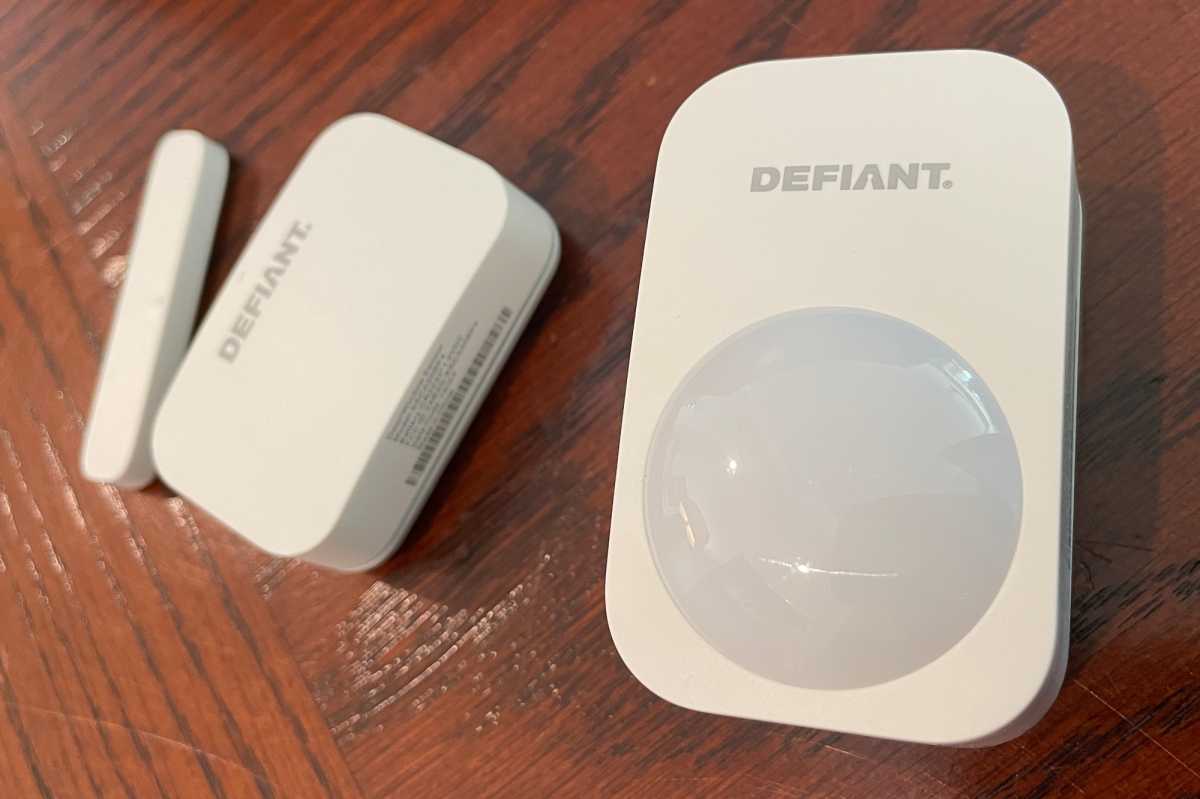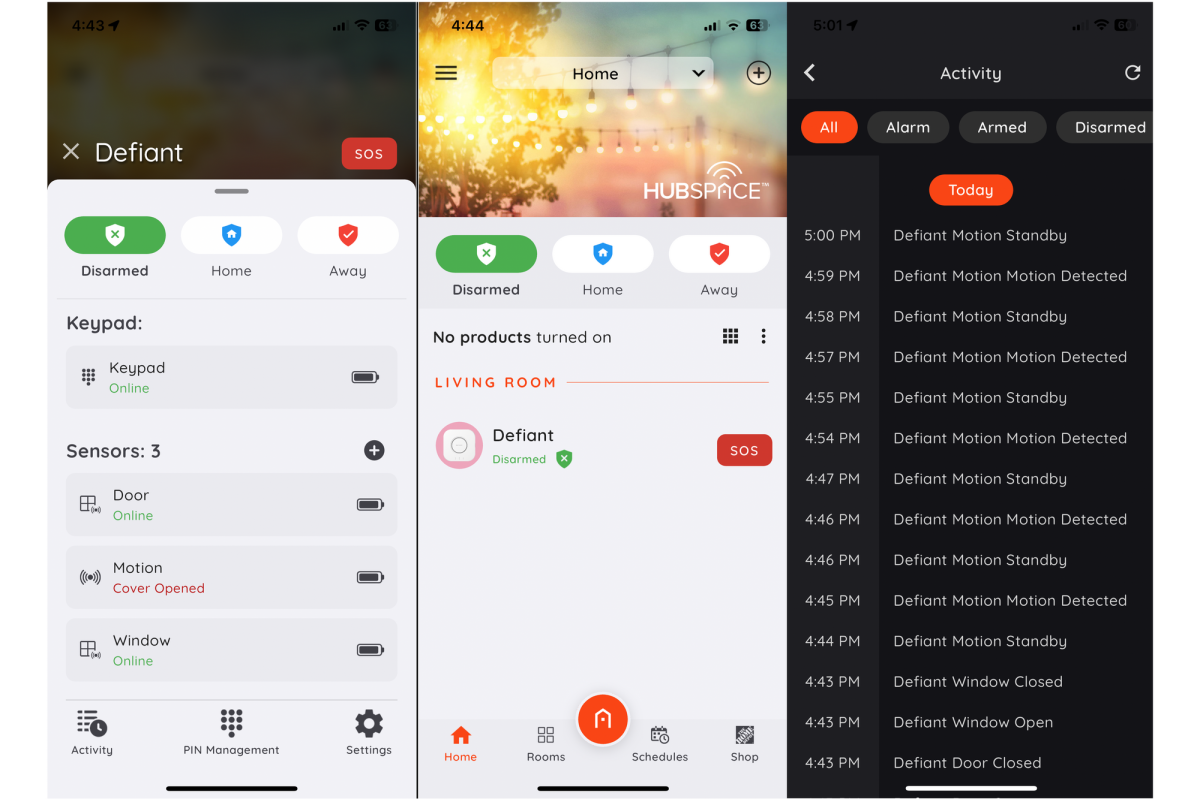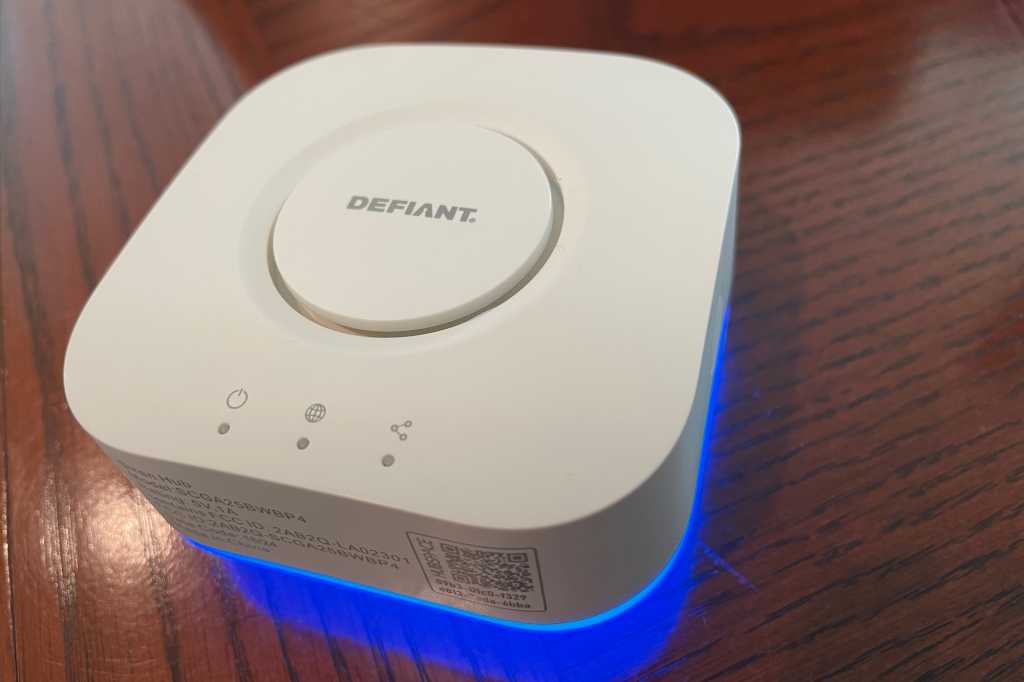Expert’s Rating
Pros
- Very loud siren
- Supports up to 32 motion and/or door/window sensors
- Can be controlled via Alexa or Google Home
- Very inexpensive, and there are no subscriptions
Cons
- Rocky setup
- Erratic sensor performance
- PINs can’t be time-restricted, and users aren’t tracked in the logs
- No professional monitoring options
Our Verdict
This security system is entry-level in every sense of the word, and it’s only appropriate to serve the most basic of security needs.
Price When Reviewed
This value will show the geolocated pricing text for product undefined
Best Pricing Today
Price When Reviewed
$99.00
Best Prices Today: Home Depot Defiant Smart Home Alarm System
I suppose if I was looking for a no-frills, absolutely basic security system, why, I might start my search at Home Depot, perhaps while I was picking up some spackle and spray paint to handle various other projects around the house. That kind of weekend warrior mentality seems to be the exact target audience for the Defiant Smart Home Alarm Kit, an utterly basic system that can fit easily in a plastic shopping bag and that won’t break the bank at all of 99 bucks.
The Defiant Smart Home Alarm Kit includes five components, all powered by Home Depot’s Bluetooth-and-Wi-Fi-based Hubspace smart home platform: A combination hub/siren, a separate keypad controller, a motion sensor, and two door/window sensors. Most of the components feature a traditional, almost anonymous design.
The kit includes a very Home Depot-like printed instruction manual, but the Hubspace app walks you through most of the setup. Unfortunately, I ran into roadblocks at nearly every step of the initial setup process, which involves onboarding the hub/siren box. Setup begins innocuously enough: Scan a QR code on the side of the siren, then walk through a few basic questions.
The siren integrated into the Defiant Smart Home Alarm Kit’s base station gets plenty loud.
But things froze after a couple of steps, when the app got stuck on a mysterious “Searching…” screen and was unable to proceed. Quitting the app and returning to it showed that the siren had been added to my Hubspace account, but without a 2.4GHz Wi-Fi connection. The device claims to be able to work on Bluetooth only, but I couldn’t do anything without a Wi-Fi connection, and attempting to manually set up Wi-Fi repeatedly failed on this screen. While the app encourages you to “complete setup using the setting below” there was no way to do so.
Home Depot’s Defiant Smart Home Alarm System starter kit includes (left to right) a numeric keypad for arming/disarming, a central hub, one motion sensor, and two door/window sensors.
Home Depot
I ended up deleting the connection to the hub, force-quitting the app, and attempting to reset the hub with its reset button multiple times, but I encountered these and other errors repeatedly. Eventually I was able to get things going by trying all of the above, removing the batteries from the hub, then trying the connection again. Finally, I was able to get the hub onboarded in the app.
The good news is that connecting the four additional devices to the hub and the Hubspace app proceeded without complaint. Each of those comes preinstalled batteries preinstalled (AAs for the keypad, AAAs for the motion sensor, and coin cells for the chunky door sensors). Setup involves removing the plastic tab to engage the battery and then holding down a pairing button for five seconds, though the process is slightly different for each device. I had all the devices connected within just a few minutes, with the most difficult step in the process being prying off the extremely tight battery cover on the door sensors.
Once paired, all devices can be wall-mounted with included screws or included, double-sided tape.
This review is part of TechHive’s in-depth coverage of the best home security systems.

The system can be expanded to a maximum of 32 sensors (door/window and motions sensors are shown here).
Christopher Null/Foundry
Note that the hub/siren device is also powered by three AA batteries, but it also has a USB port for additional power; this port must be used during setup, and the manufacturer recommends leaving it plugged in 24/7. Certain features—including door/window chimes—will not function when the hub is running on battery power.
With everything configured, it’s time to start using the system. Enabling and disabling the alarm system can be done either in the Hubspace app or via the numeric keypad. Operations are simple either way, covering the basics without a lot of extra fuss.
The app offers access to three modes—disarmed, home, and away—which operate as expected and helpfully illuminate the base of the hub when activated. Away mode turns on all sensors, while home mode disables motion sensors by default. Each individual sensor, however, can be configured to activate in either home, away, or both modes, which allows you to turn off particular sensors altogether if desired, or you set the motion sensor to stay active while you’re home. An SOS button lets you sound the alarm on demand.
Options in the app let you configure various arming delays and the duration of the volume-adjustable siren—which is plenty loud at max. You can also set different sounds for the siren and the chimes. Curiously, the motion sensor defaults to also initiating a chime as well as the door and window sensors, but this behavior can be disabled for any or all sensors.

The central hub can operate on backup battery power in the event of an outage, but the systems door and window chimes won’t sound off while it’s running on batteries.
Christopher Null/Foundry
Sensor performance was a little erratic during my testing, particularly for one of the door chimes, which didn’t properly register a state change every time it was opened or closed. It would often report being open when in fact it was shut, forcing me to open and shut the door a few times before the sensor status would finally change.
This is especially problematic because you can’t put the system in its armed state if a door or window is registered as being open unless you manually bypass the faulty sensor. What’s more, on my first day of testing, the motion sensor incorrectly reported that its back cover was open, which required several remove-and-replace cycles to resolve the issue.
User/PIN management is very basic. The system lets you create 4- to 8-digit PINs and assign a name to each, but every PIN provides full 24/7 access; there’s no way to restrict admittance to dates or times. Lastly, while the system includes detailed logs that track all sensor activity, arm/disarm state changes, and alarm activations, you won’t know who armed or disarmed the system because the log doesn’t record PIN use. This can be a big problem if you have multiple users, because there’s no way of knowing who the last person in the house was if something goes awry.
Much like the app, the keypad provides an offline way to arm and disarm the system and to manually activate the siren with the SOS button. Other than this, a few small LEDs serve to provide occasional status information, such as informing you if a door has been left open when you’re trying to arm the alarm. Again, it’s very basic with few frills, but it generally gets the job done.

Hubspace veterans will find the Defiant Smart Home Alarm System’s mobile app familiar.
Christopher Null/Foundry
The Defiant system sends notifications to your phone for various activities, but I found these to be somewhat erratic, sometimes arriving out of order and/or slowly, with notifications that the alarm had been disarmed and the siren activated—in that order—up to a minute after both events had occurred. That’s not a catastrophic length of time, but it isn’t ideal.
It’s also critical to note that Defiant has no professional monitoring option or any way to connect to emergency services. It’s completely self-monitored, so really what you’re getting is a loud siren and push notifications that your alarm has been activated. The inclusion of an SOS button can be particularly misleading on this front, as the button does not (and cannot) call for police, fire, or emergency medical services. It simply activates the siren.
Given its $99 price tag, one should probably keep expectations in check. That outlay doesn’t get you much, of course, and I expect even very basic security needs won’t be met without some additional motion sensors ($10 each) or door/window sensors ($35 for two). The hub supports a maximum of 32 sensors of all types. There’s no way to integrate this system with other home security devices, such as floodlights–even Hubspace-branded ones–and there are no Hubspace security cameras at this time. The system does offer basic control via Alexa or Google Home.
Still, even as a bare-bones, rock-bottom-priced security system, the Defiant system leaves a bit to be desired. This might be an acceptable product ifyou’re trying to scare hooligans away from a shed in your backyard, but I can’t see anyone relying on such a simplistic and often buggy product to protect the homestead.

